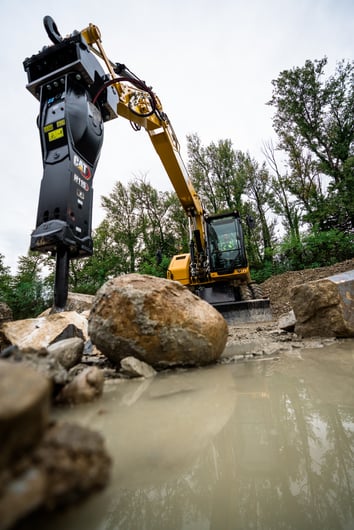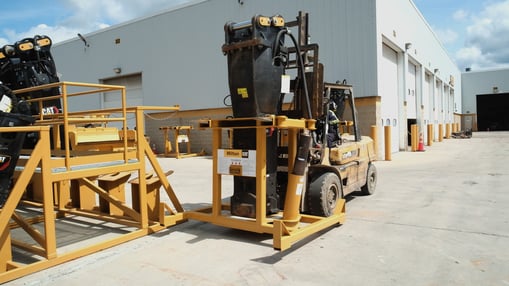No matter if you’re making an investment in a machine, attachment, or part, the first thing on your mind after the initial purchase is probably, “How can I get the most bang for my buck?” Getting the greatest return on your investment will take some effort, but the work will be worth it. Careful attention is required for attachments like hydraulic hammers that work in harsh conditions because costly damage can occur quickly if the attachment isn’t maintained, operated correctly, or properly stored.
Proper maintenance is all about consistency. Before every use, inspect your hammer for loose bolts; fluid leaks; and broken, worn, or missing parts. Ensure the hydraulic connections are secure. Grease the hammer at least once per use to prevent excessive wear of the tool and bushings. Most manufacturers provide recommended greasing intervals for their specific models of hammers. If the hammer has an automatic lubrication system, inspect it daily to ensure the grease line connections are secure and the grease cartridge is full.
 Operator technique can significantly impact the life of your hydraulic hammer attachment.
Operator technique can significantly impact the life of your hydraulic hammer attachment.
Taking some time to train your operator on hammer operation can also go a long way towards maximizing the attachment’s working life. Here are some operation tips to keep in mind. Operators should keep the hammer moving by starting at the material’s edge and working inwards. Don’t hammer the same spot for more than 15 seconds. If the rock does not break, reposition the tool every 15 seconds until it breaks. Always hold the hammer perpendicular to the material being broken and avoid blank firing by making sure the tool tip is in contact with the rock’s surface before hammering. Prying or using the tool as a lever to maneuver material is a common operator mistake that can damage the hammer. Once the material is broken, use another attachment such as a bucket with teeth, bucket with a thumb, or grapple to remove it.
While proper operation and maintenance are critical to maximizing the life of your hydraulic hammer attachment, the way you store the attachment when not in use is just as important. Hammers must be stored vertically, especially in Massachusetts where we have wet and cold winters. Storing hammers horizontally could lead to costly damage. The cylinder seals could flatten due to the weight of the piston. If stored outside horizontally, water could collect inside the hammer and quickly rust the parts and sealing surfaces. Significant damage could also be caused by the water freezing. When the hammer is stored vertically the water will run off the hammer.
While it may be easy to vertically store smaller hammers for skid steers and mini excavators, it can be more challenging to properly store hammers for large excavators. The size and weight of larger hammers make it difficult to maneuver and secure them safely. Although there are stands for large hammers, they are not always easy or safe to use. Typically, hammers are stored with the tool bit installed because there is nowhere to put it on most hammer stands. This creates a high center of gravity and makes the hammer more likely to tip over. Multiple people and the carrier machine are often required to mount a hammer in a stand. Pin hole hammer stands aren’t designed to prevent the hammer from moving back and forth during transportation. This can cause damage to the tool bit. Several brands of hammer stands are available on the market so be sure to consider your specific needs before purchasing. To make storing and transporting CAT H130-H180 hammers easier and safer, Milton CAT has designed its own line of stands specifically for ease of use, safety, and protection. Milton CAT hammer stands hold hammers vertically to prevent water damage and the top plate prevents the hammer from shifting side to side. There is a dedicated tool pocket so the tool bit can be removed, decreasing the risk of tipping. The gated door minimizes the height the hammer needs to be lifted when mounting it in the stand. The fork pockets allow appropriately rated forklifts to easily move the hammer in the stand. For added stability, the pockets are located above the hammer’s center of gravity.

While proper operation and maintenance are critical to maximizing the life of your hydraulic hammer attachment, the way you store the attachment when not in use is just as important.

To make storing and transporting large hammers easier and safer, purpose-built stands ensure ease of use, safety, and protection.
My last tip for maximizing the life of your hydraulic hammer or any other attachment is to utilize the resources at your equipment dealership. While there are a lot of great resources available, sometimes it is more efficient to go straight to the source. Some dealerships even have a dedicated service helpline that you can call to get your questions answered.
